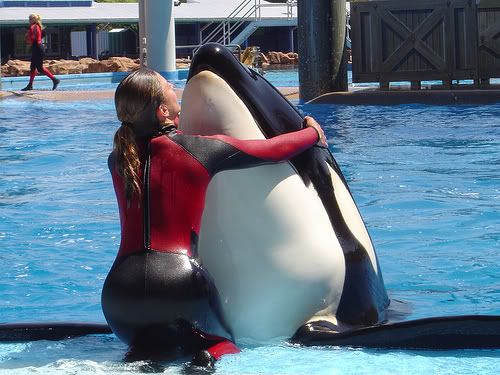The recent killer whale incident that cost the life of trainer, Dawn Brancheau is a tragedy.
Any time you work closely with a captive wild animal, or have a close encounter of the wild kind in nature, a human is at risk.
Granted, it is a calculated risk–but one that all animal trainers take.
To boil it down for you, death or dismemberment by an animal attack is actually an occupational hazard, something that most people tend to dismiss, push under the carpet, or conveniently forget.
I was traveling all day yesterday and was sad to hear about the incident but there are lots of incidents that happen every year and that we don’t hear about because most don’t result in the death of a trainer.
Now everyone is chiming in on this topic and here are a few of my comments.
First, I am so very sad–as I always am when someone loses their life working with animals. My best wishes and condolences go out to all those who knew or worked with Dawn Brancheau.
I’m also saddened at the people who jump to conclusions without examination of the incident.
Captive wildlife exists and they are exactly why people even care about whales and other wildlife.
I know, I was narrating whale watch trips and going to Marineland of the Pacific when whaling was still a common practice.
People thought they were fish and fishermen shot whales because they were competition for the human fishing industry.
Today the pendulum has swung in the other direction and people think they need to be set free.
Is captivity right or wrong?
I really don’t have an answer for you.
I’ve worked with captive wildlife so long that I do believe those close encounters make a difference but the captive conditions and practices of animal management vary greatly.
To those who say the killer whale was playing–what an irresponsible suggestion. The killer whale trainer was pulled into the tank by her pony tail but the reason for the action has not been identified.
Sometimes things just happen and you don’t know the trigger. Trainers discuss, analyze, and hypothesize but only the animal knows for sure.
Also, in response to the person that likened it to that behavior of playing with the seals?
That is predatory behavior, and make no mistake, it is aggressive.
If you have watched footage of previous attack incidents with other killer whale trainers, the orcas take those same actions and they don’t resemble play.
I’ve only witnessed two types of things happen when trainers or caretakers die.
The first is human error and the second is the intent to harm by the animal.
Maybe “intent” is the wrong word because predators (or any wild animals) just do what they do, unlike human intentions, it is part of their regular behavioral makeup or repertoire.
I’ve seen pissed off whales come onto the stage to threaten trainers before and we don’t know if Tilikum (aka Tilly) was agitated.
There is one thing I know for sure, someone is dead and the wild animal, a killer whale (Orcinus orca), was responsible.
Wild animals that are predators are good at it.
Should Tilly be killed, blamed?
No, definitely not.
The other definite here? He is one big predator. 12,000 pounds of muscle and grace in the water.
Should all the commentators blab this for ages about this? Lets hope not. I liked this commentary by Hal Boedeker.
Best to move on.
In the meantime, some professionals are stepping up and commenting. I think this excerpt from Karen Pryor’s Clicker Training website said it best:
Does this mean that we should not work with these animals in captivity? We believe that the great work from what we learn from these animals far outweighs the small risk. For decades, dolphins and whales in captivity have served as ambassadors for their species. Before oceanariums existed, there was little education or respect about these magnificent animals. Killer whales were used by the military for bombing practice. Dolphins were strictly viewed as competition by fisherman and treated as pests the same way that a farmer views a trespassing coyote. Without oceanariums, there would be no Marine Mammal Commission or worldwide protection regulations. We have made tremendous progress in our respect and understanding of animals, none of which could have happened if it had not been for Flipper and other animals in captivity.
My hope is that the professional animal training and management industry will do something useful with this incident to move the profession forward and to educate the general public.
You can read some of my previous killer whale attack, orca attack, and other killer whale commentaries on the Ark Animals website plus I’ve include a couple of other notable links:
- 2006 Orca Attack
- 2006 Killer Whale Attack
- Keiko of Free Willy
- Article about Keiko before his death.
- Frontline’s Whale of a Business discussed Tilly
- Perks of a killer whale trainer’s job
- Flagship species Orcinus orca
Diana L Guerrero has been working in wild and domestic animal training and management since the 1970s. Known as the Ark Lady, she is graduate of the exotic animal training and management program and holds certifications in captive breeding and conservation and endangered species and other animal specialties. She is contributing editor to Resources for Crisis Management in Zoos & Other Animal Care Facilities and wrote an animal behavior and training column for the zoo industry for ten years.
Last updated on 2-26-2010
Sea World corporate will issue a statement at 10am PST.


